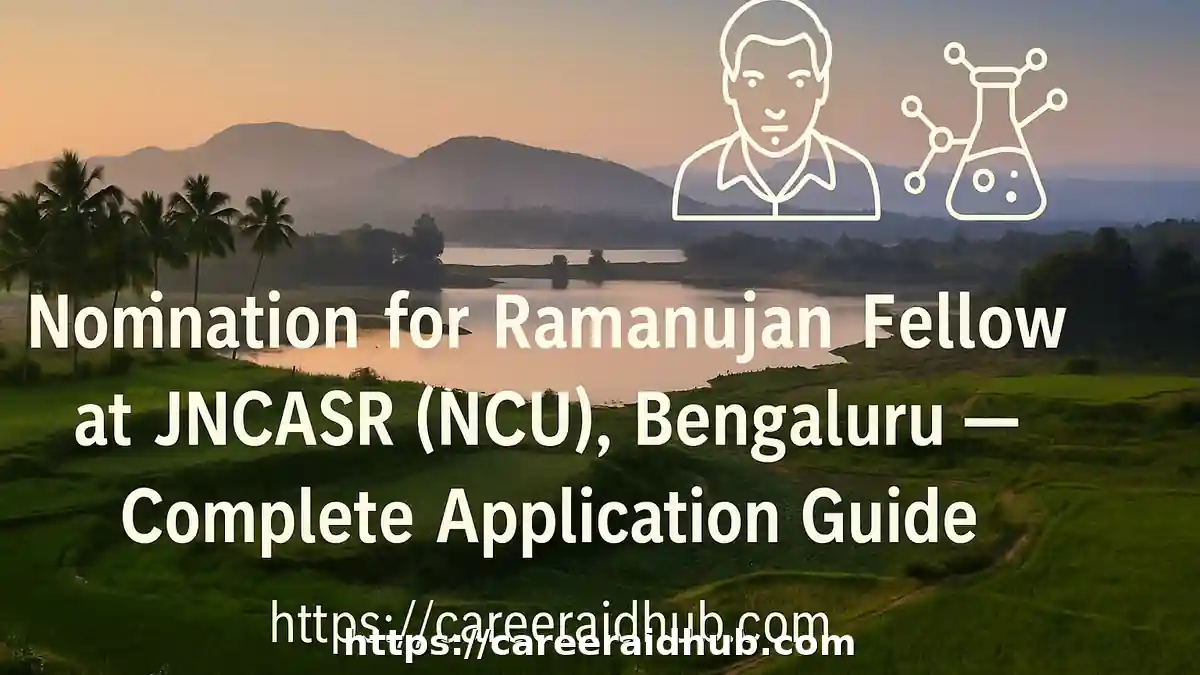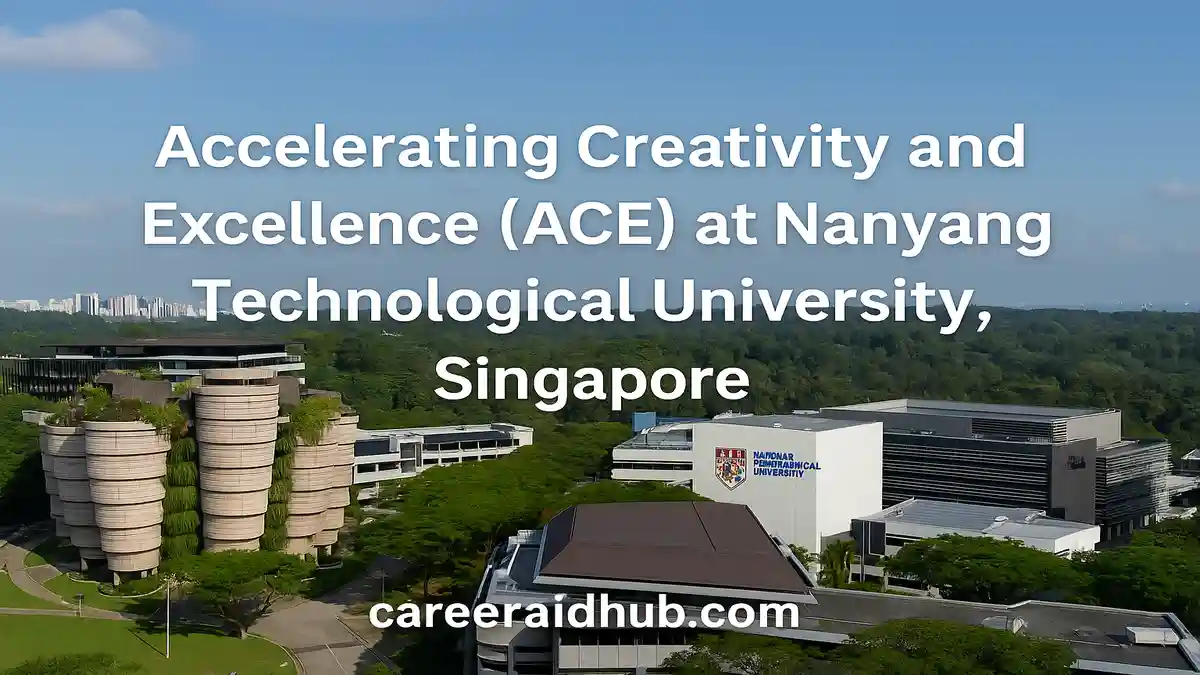Introduction
The New Chemistry Unit (NCU) at the Jawaharlal Nehru Centre for Advanced Scientific Research (JNCASR), Bengaluru invites outstanding early-career chemists to seek institutional nomination for the Ramanujan Fellowship. This invitation is aimed at researchers who are ready to design an independent program, build a small team, and contribute to the unit’s teaching and mentoring ecosystem. In brief, the fellowship provides a consolidated monthly fellowship and a dedicated annual research grant, allowing you to establish a focused, high-impact agenda while leveraging the host’s shared facilities and mentorship. For the current structure of benefits and governance, consult the official Ramanujan Fellowship page maintained by India’s national research funding agency.
Launch your independent chemistry research at JNCASR’s New Chemistry Unit. This guide explains eligibility, dossier preparation, selection flow, and hosting terms for Ramanujan Fellowship nominations—plus practical planning for budgets, facilities, and mentoring—so you can apply with confidence and hit the ground running.
What JNCASR Is Inviting You To Do
JNCASR—through the New Chemistry Unit—is accepting applications year-round from Indian nationals who seek the centre’s host-institution nomination. If you are selected by the national program, JNCASR will extend administrative support and access to essential R&D infrastructure
for the fellowship tenure. However, and this is crucial for expectation-setting,
no commitment exists to offer a regular faculty position after the fellowship ends.
Unit Focus and Expectations
JNCASR encourages proposals that complement active work within NCU or introduce novel, frontier-area expertise. As a prospective fellow, you should be prepared to:
-
- Lead an independent research program, scoped for early traction and clear milestones.
- Co-mentor Master’s and PhD scholars with regular faculty, providing day-to-day guidance.
- Contribute to teaching and outreach, thereby strengthening the academic rhythm of the unit.
This balanced portfolio—research, mentoring, and teaching—signals institutional fit and accelerates your integration into the NCU community.
Why Consider JNCASR as Your Host?
Interdisciplinary Depth, Compact Scale
Because JNCASR is deliberately interdisciplinary, materials chemists collaborate naturally with chemical biologists, theorists, and device physicists. The centre’s compact scale simplifies access to colleagues and instrumentation, which shortens the time from idea to experiment.
Infrastructure and Mentorship
Shared facilities—spanning spectroscopy, microscopy, electrochemistry, imaging, micro/nanofabrication, and computation—allow rapid method setup. Moreover, proximity to experienced PIs means technical troubleshooting and proposal feedback are available when they matter most.
Bengaluru Advantage
Being in Bengaluru multiplies
opportunities: national laboratories, deep-tech startups, and industrial R&D groups are close by. As a result, fellows often find
adjacent collaborations,
co-funding, or
translational pathways that expand the impact of their research.
Tip: In your Statement of Purpose (SOP), identify two JNCASR facilities essential to your work and explain how they shorten the validation cycle.
Fellowship Benefits (Program-Level Snapshot)
While JNCASR’s notice addresses the host nomination, candidates frequently ask about fellowship-level support to plan budgets and staffing. The national program typically includes:
-
- A consolidated monthly fellowship designed for independent early-career researchers.
- An annual research grant to cover consumables, minor equipment, domestic travel, publication costs, and limited personnel (e.g., JRF/PA).
- Host overheads paid directly to the institute, ensuring access to administrative services and core facilities.
Always verify amounts, heads of expenditure, and disbursal rules on the official program page before finalizing your costings.
Eligibility and Shortlisting at JNCASR–NCU
Minimum Eligibility
-
- PhD in a relevant discipline.
- At least two years of post-doctoral experience.
- A demonstrable record of high-quality publications and strong academic credentials.
Shortlisting Process
-
- An expert panel reviews all dossiers for fit, feasibility, and potential.
- Seminars and interactions with NCU faculty follow for shortlisted applicants.
- The
top candidate receives JNCASR’s host endorsement/sponsorship, enabling submission to the national fellowship.
Avoid a common misstep: proposals that are over-ambitious for a two-to-three-year horizon often underperform in panel discussions. Right-size your aims.
What to Submit
Send one merged PDF to the Chair, NCU at [email protected]. Arrange the document with clear bookmarks and a logical order:
-
- Curriculum Vitae with a complete publication list (include DOIs).
- Completed fellowship application; if the national portal is not open, include a detailed statement of your future research programme.
- Three most significant publications (full PDFs) with a brief impact note each—state the main result and why it matters.
- Statement of teaching interests—courses you can offer, prior teaching experience, and any outreach.
- Contact details for at least three referees who can address independence, creativity, and leadership.
Submission hygiene: Name the file YourName_RamanujanNomination_JNCASR_NCU.pdf. Include a table of contents and page numbers.
Building a Competitive Research Plan (Chemistry Focus)
1) Position Your Niche Clearly
Define two or three cohesive themes that reinforce each other. For each theme, articulate the central hypothesis, specific objectives, and experimental or computational strategy. Then, align outputs to publishable units with realistic venues.
style="text-align: justify;">
2) Match Work Packages to Facilities
List the critical instruments and analysis pipelines you will use—e.g., in situ spectroscopy, operando electrochemistry, high-resolution microscopy, or DFT/MD simulations. Map these to JNCASR facilities or nearby national labs; state any training you require in the first quarter.
3) Plan People, Time, and Budget
From the annual grant, budget for one JRF/PA, consumables, and travel to a targeted conference that directly benefits your project. Use a quarter-wise Gantt chart with go/no-go criteria so reviewers see how you will adjust course if a route underperforms.
4) Anticipate Risk and Create Downside Protection
Balance a high-risk/high-reward idea with low-risk, data-generating tasks that steadily produce publishable results—e.g., benchmarking catalysts on standard substrates while exploring a bold mechanism on a harder system.
5) Connect to Broader Value
Tie outcomes to national S&T priorities such as energy materials, sustainable catalysis, and advanced characterization. Where appropriate, mention data-sharing or preprint practices that improve transparency and accelerate community uptake.
Teaching & Mentoring Statement: What NCU Expects
Proposed Courses
Outline two modules you can teach immediately—one advanced elective (e.g., Electrocatalysis and Operando Methods) and one lab-intensive module (e.g., Spectroscopy for Materials Chemists). Provide 2–3 learning outcomes for each.
Mentoring Approach
Describe how you will co-supervise MSc/PhD students with a regular faculty mentor, run weekly group meetings, and implement lab notebooks, data management, and pre-submission internal reviews.
Safety, Integrity, and Outreach
Commit to safety inductions, SOPs, and integrity training in the first month. Propose one outreach activity—for example, a mini-school on “Experiment-Simulation Synergy in Materials Chemistry.”
Letters & Referees: Getting the Most from Your Champions
-
- Select diverse voices: one PhD advisor, one postdoc mentor, and one collaborator or industry PI.
- Provide a briefing kit: a two-page research summary, slides from a recent talk, and your teaching outline.
- Request specificity: ask referees to cite originality, independence, and team-leadership potential.
- Time it well: confirm availability in advance; seminar rounds can move quickly.
After Shortlisting: What Happens Next
Shortlisted applicants deliver a 30–40 minute seminar followed by a Q&A and small-group interactions. These conversations test fit, feasibility, and synergy with NCU labs. If you are selected, JNCASR issues the host endorsement needed for the national application. Keep an eye on the national portal for form fields, document formats, and timelines so your submission is ready the moment the window opens.
Timeline & Planning
-
- Institutional window (JNCASR–NCU): open all year; submit when your dossier is complete and referees are primed.
- National cycles (predictive guide): announcements commonly cluster around February–March and September–November. Prepare a portal-ready package and track updates—we will update soon with the next cycle months once officially notified.
Calendar discipline: Block two weeks for final checks before any anticipated national window—formatting, scans, and reference letters often take longer than expected.
Where to Check and Apply
-
- JNCASR nomination page (NCU) — read the announcement and PDF instructions.
- JNCASR openings index — confirm status and see related opportunities across units.
- Ramanujan Fellowship program page — verify financial heads, eligibility, and submission rules.
Frequently Asked Quick Answers
- Citizenship. The call is for Indian nationals; if you are currently abroad, confirm continued eligibility on the national program portal.
- Host commitment. JNCASR provides administrative support and access to core facilities; no automatic regular appointment is implied.
- Unit fit. Emphasize complementarity with NCU’s research and the distinctive expertise you bring.
- Contact. Email [email protected] with your single-PDF dossier and a clear subject line.
Step-By-Step Submission Checklist
-
- Draft a two-year plan with milestones, risk-mitigation, and target journals.
- Assemble the merged PDF: CV → proposal/application → three key papers (with impact notes) → teaching statement → referees.
- Email the PDF to [email protected]; use: “Ramanujan Fellowship Nomination — YourName (NCU)”.
- Prepare your seminar: hypothesis, methods, early data (if any), risk/alternatives, and student roles.
- Monitor the national portal; once endorsed by JNCASR, submit promptly with all required forms.
Programme Snapshot
|
Feature
|
Details
|
|
Program Name
|
Ramanujan Fellowship — Institutional Nomination (Host: JNCASR, New Chemistry Unit)
|
|
Host Country
|
India
|
|
Funded By
|
National research funding agency (Ramanujan Fellowship) with JNCASR as host
|
|
Duration
|
Typically multi-year fellowship (consult program rules)
|
|
Study Mode
|
Full-time, in-person at host institute
|
|
Eligibility
|
Indian nationals with PhD, ≥2 years postdoc experience, strong publications
|
|
Financial Support
|
Consolidated monthly fellowship; annual research grant; host overheads as per rules
|
|
Fields of Study
|
Chemistry and allied/frontier areas that align with NCU and JNCASR facilities
|
|
Deadline
|
Institutional window: year-round; next national cycles February–March and September–November (predictive; we will update soon)
|
|
Official Website
|
Ramanujan Fellowship — Click here
JNCASR (NCU) — Click here
|
Conclusion
For high-potential chemists seeking rapid independence, the JNCASR–NCU nomination route into the Ramanujan Fellowship offers a clear runway: strong facilities, collaborative mentors, and a focused grant that rewards disciplined planning. Assemble a rigorous dossier, align your methods with available instrumentation, and demonstrate teach-mentor capability from day one. For definitive rules, submission formats, and benefits, rely on the official JNCASR notice linked below.
Frequently Asked Questions (FAQs)
What is the Ramanujan Fellowship at JNCASR (NCU)? It supports early-career scientists to establish independent research at JNCASR’s New Chemistry Unit; moreover, it includes a consolidated fellowship and an annual research grant.
Who is eligible for JNCASR’s Ramanujan Fellowship nomination? Applicants typically need a PhD, at least two years of postdoctoral experience, and strong publications; additionally, proposals must align with the New Chemistry Unit’s research.
How do I apply for JNCASR’s host-institution nomination? You email one merged PDF (CV, proposal, key papers, teaching statement, referees). Then panels shortlist candidates for seminar and interaction rounds.
Does the Ramanujan Fellowship guarantee a permanent position at JNCASR? No. The fellowship provides hosting and infrastructure; however, it does not imply a regular appointment after completion.
What funding does the Ramanujan Fellowship usually provide? It typically offers a consolidated monthly fellowship and an annual research grant for consumables, personnel, and travel; consequently, you can launch a focused program.
Which research areas fit best at JNCASR’s New Chemistry Unit? Proposals in frontier chemistry—materials, catalysis, electrochemistry, chemical biology, or theory-experiment interfaces—fit well; furthermore, interdisciplinarity strengthens competitiveness.
When should I submit the nomination dossier to JNCASR? You may submit year-round; nevertheless, prepare early so you can meet national portal windows once they open.
What should my research plan include for Ramanujan Fellowship success? Define clear hypotheses, feasible milestones, facility usage, risks, and go/no-go criteria; additionally, show complementary low-risk tasks that generate steady outputs.
Can I co-mentor students while on the Ramanujan Fellowship at JNCASR? Yes. Fellows typically co-mentor MSc/PhD scholars with regular faculty; therefore, include a concise mentoring approach in your dossier.
How competitive is JNCASR’s nomination for the Ramanujan Fellowship? It is highly competitive; thus, align with unit strengths, demonstrate independence, and present a realistic two-year plan with measurable deliverables.
Premium Mentorship for a Stronger Application
- Premium Mentorship: personalised 1:1 guidance for this and similar opportunities
- In-depth review of your CV, academic profile, and key statements
- Aligned with international selection criteria so your profile matches what panels expect
- Stronger, more compelling narrative for highly competitive calls
- Step-by-step support from opportunity mapping to final submission (fee-based)
Subscribe Premium Mentorship










